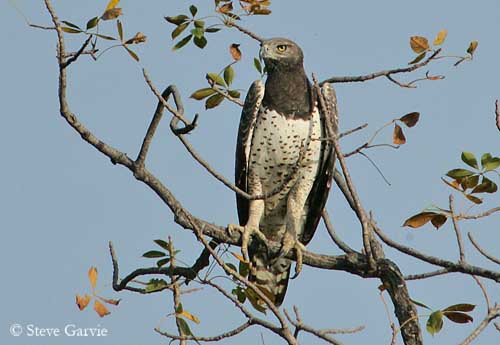
Text by Nicole Bouglouan
Photographers:
Steve Garvie
RAINBIRDER Photo galleries
Tom Merigan
Tom Merigan’s Photo Galleries
Callie de Wet
GALLERY
Sources:
BIRDS OF PREY OF AFRICA AND ITS ISLANDS by Alan and Meg Kemp - Struik Publishers - ISBN: 1770073698
HANDBOOK OF THE BIRDS OF THE WORLD Vol 2 by Josep del Hoyo-Andrew Elliot-Jordi Sargatal - Lynx Edicions - ISBN: 8487334156
Booted eagles
Genera Polemaetus, Lophaetus and Stephanoaetus
These three eagles occur in Africa, south of the Sahara. They are resident in their range, sometimes with local irregular movements, but the young birds often disperse.
1- Genus Polemaetus: Martial Eagle - Polemaetus bellicosus
The Martial Eagle is a large raptor with a length of 80-86 cm and a wingspan of 210 cm.
The main features are the large head and the long wings. Flight feathers and tail are black with narrow dark grey bars. Upperparts are dark brown with pale buff edges, and underparts are white, slightly spotted brown.
Head, neck and upper breast are dark brown. The legs are feathered and the long bare feet are dull yellow. The bill is black with yellow cere. The eyes are deep yellow.

This large eagle frequents the open areas such as desert and steppes, grassland and woodland. It ranges from Senegambia E to Ethiopia and S to South Africa, and the species is resident with only some irregular movements.
The Martial Eagle feeds on large birds such as gamebirds and waterfowl, mammals from hares to small antelopes and large lizards according to the habitat.
This species hunts on the wing soaring high for long periods while searching for preys. Then, it performs a long, shallow dive and catches the prey by striking. It also may remain concealed behind the cover to surprise the prey which can be caught on the ground or in the air.
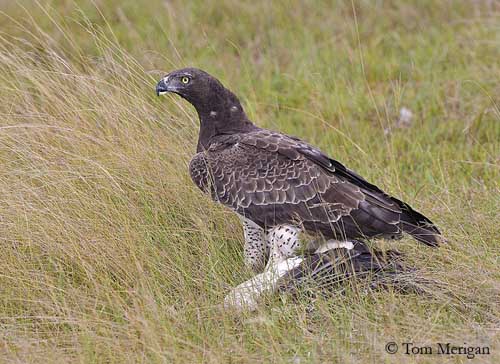
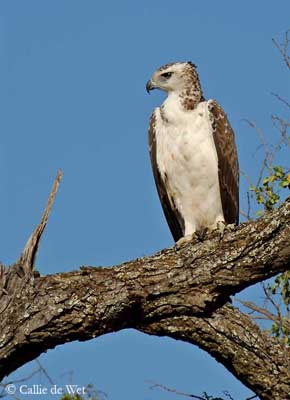
The stick nest is very large and lined with green leaves. It is placed in tree fork, pylon, cliff or boulder, always in open areas.
The female lays a single egg and incubates during 47-50 days. The chick is fed by both parents, and fledges about 95-100 days after hatching, but it may depend on parents for long period, up to 8-12 months.
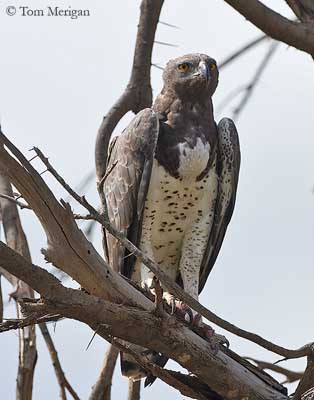
The Martial Eagle is common and widespread in some parts of Africa, and occurs in national parks and reserves. This species is still heavily persecuted because it catches poultry and small livestock in farmlands. However, this species is not currently threatened.
2- Genus Lophaetus: Long-crested Eagle - Lophaetus occipitalis
The Long-crested Eagle is smaller with a length of 55-58 cm and a wingspan of 115 cm. The long, erect crest on the hind crown makes this eagle unmistakable. It has broad rounded wings, and the white carpal patches on the underwing are conspicuous in flight. The body plumage is sooty-brown overall, except on underwing and feathered legs. The bill is black with yellow cere. The eyes are deep yellow. The bare feet are yellow.
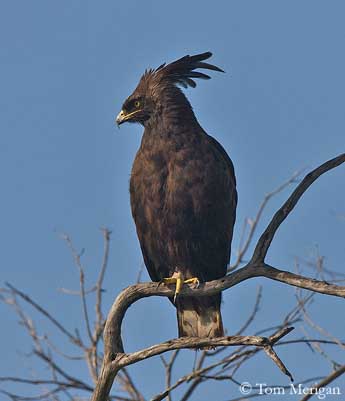
This eagle ranges from Senegambia E to Ethiopia and S to N Namibia, N Botswana and E South Africa. It frequents forest and woodland edges along marshy areas and grassland, cultivated patches and plantations.
This species does not perform regular movements, but some local movements are reported according to the wet and rainy seasons.
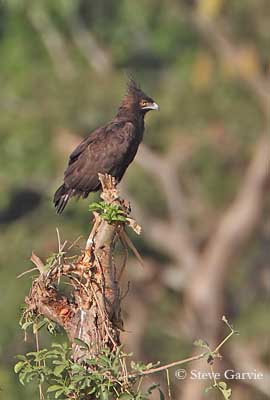
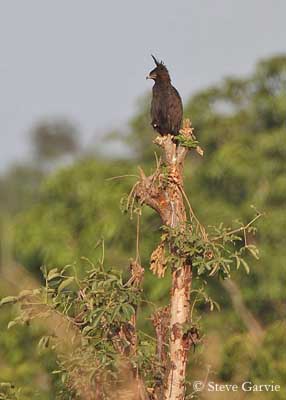
It feeds on small mammals, mainly rodents, and some birds such as francolins, and also reptiles and large insects. It hunts from prominent perch, waiting for long periods, and swooping down onto the prey on the ground. It may soar at medium height between two perches.
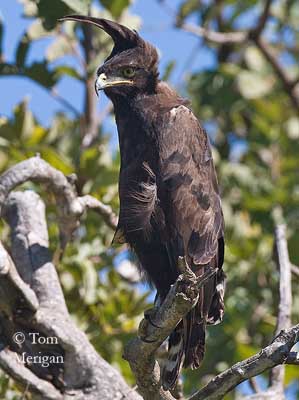
The stick nest is a small platform in tall tree, usually at forest edge.
The female lays 1-2 eggs and incubates during 42 days. The chicks are fed by both parents and fledge about 53-58 days after hatching. Two chicks are usually raised.
The Long-crested Eagle is common is wet areas with patches of woodland and forest. The species is vulnerable to degradation of wooded habitats and drainage of wetlands, but it may use exotic plantations and small cultivated patches, and also secondary forest. It is not currently threatened.
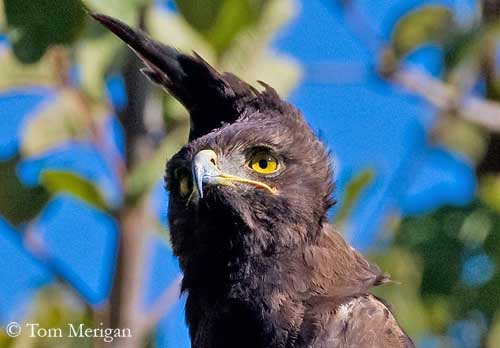
Genus Stephanoaetus: Crowned Hawk-eagle - Stephanoaetus coronatus
The Crowned Hawk-eagle is fairly large with a length of 80-99 cm and a wingspan of 163-180 cm. It has short, rounded wings and long tail. Unlike the previous eagles, this one has small face and voluminous black-tipped crest. Upperparts are dark slate-grey with paler head and neck, mostly rufous-brown. Underparts are black with variable white and rufous barring. The feathered legs are white and may be spotted or barred black.
On the underwing, coverts are bright chestnut, and greater coverts are black and white. Flight feathers and rectrices are white barred black.
The bill is black with grey cere. The eyes are pale yellow. The heavy feet are orange-yellow.
The juvenile is pale grey above with white feather edges giving scaled effect. Head, neck and underparts are whitish. On the head, crown and crest have grey feather bases visible when erected. On the underwing, coverts are pale rufous, as the upper breast. The eyes are grey.
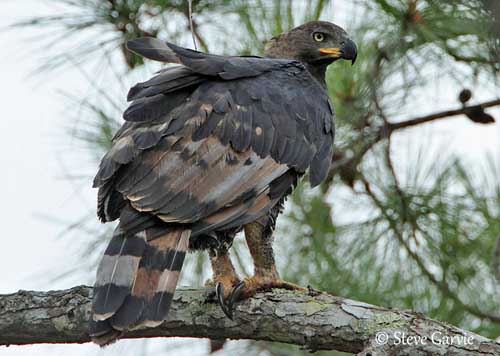
This large eagle occurs from Senegambia to S Kenya and C Ethiopia, and S to Angola, NE Botswana and E South Africa. It is resident and sedentary in its range.
It frequents lowland rainforest to montane forest according to the range. It often occurs in dense forest and woodland. When hunting, it may move into dry savannah and secondary forest.
It feeds on mammals such as monkeys and small antelopes, and other animals according to the wet or dry habitat. Its preys include porcupines and squirrels, pigeons and other gamebirds, and large lizards.
This is a very powerful eagle which hunts from perch and drops onto the prey, or stoops from soaring flight. Both mates may hunt together in aerial attack strategy. The larger preys of up to 20kg are dismembered and cached in tree forks.
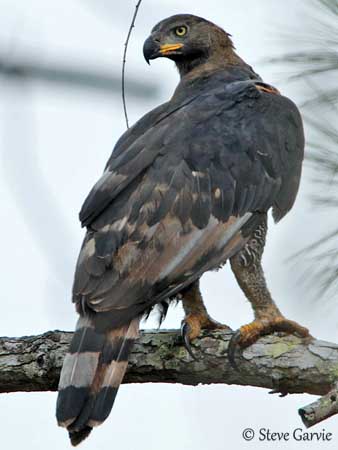
During the breeding season, the Crowned Hawk-eagle performs aerial displays above the territory, accompanied with loud calling.
The stick nest is a large structure lined with green leaves, and placed in the main fork of large tree in forest. This nest is often reused year after year.
The female (displayed) lays two eggs but usually, only one chick is raised. Incubation lasts about 49-51 days. The young is fed by both adults, and fledges 90-115 days after hatching. It depends on parents for long period, from three months to one year.
This species is common and widespread in extensive lowland forest habitat. It is vulnerable to deforestation and lack of preys due to overhunting. This eagle may be persecuted in some parts of Africa for some small-stock losses. But the species is not currently threatened.